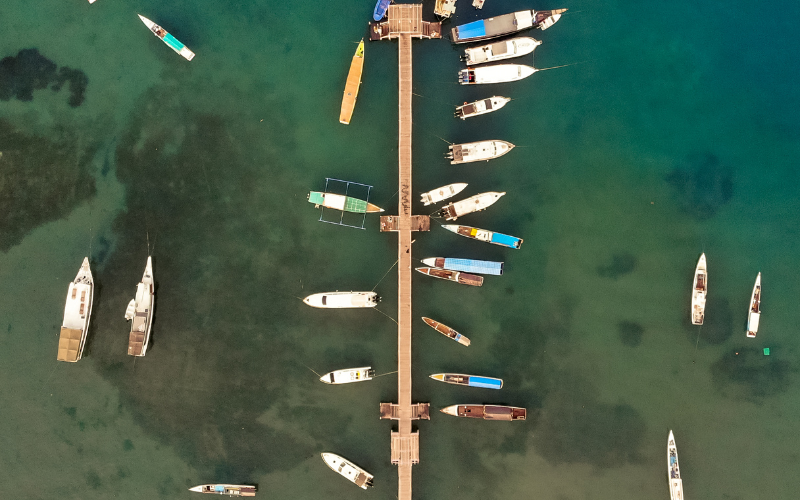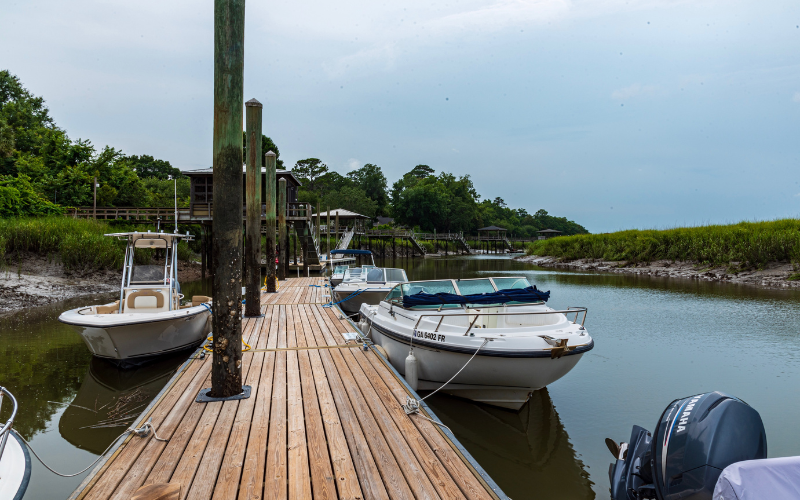Docking and Undocking
Getting the boat away from the dock can sometimes be challenging if the wind and current are contrary and other boats are nearby. With inboard and inboard/outboard engines, the bilge blower must be turned on for a minimum of four minutes to clear away any explosive fumes that may have collected. The size of the engine does not determine how long you need to turn on the blower to clear the bilge of potentially dangerous fumes but rather the volume of the bilge. The more volume the more time is required.
A simple check is to use your nose to take a quick “sniff” to see if you smell fumes. If you do, then let the blower run a few more minutes until the bilge is clear. Remember, four minutes operation of the blower is only the required minimum.
The engine is then started and warmed up before any lines are cast off. The direction and strength of both wind and current should be checked to assess which will have the stronger effect. The actions of other boats are watched to see which may be leaving, arriving, or passing nearby, because a boat that is leaving a dock has no right of way over other boats.
As described earlier, a boat is steered by pushing the stern in the opposite direction from that in which the bow is required to go. An attempt to undock by turning the rudder away from the dock and engaging forward gear simply swings the stern against the dock. It is, therefore, generally good practice to leave in reverse, after first checking the position and movements of other boats in the vicinity. In all cases, the exact steps to take are dictated by the combined effect of wind and current. Care must be taken to react to the one that has the greater effect.
Tips on undocking a boat under different sets of circumstances are given in the following paragraphs, but considerable practice is required before it can be done successfully. The procedures are based on a well-equipped boat with sufficient and competent crew. Skippers will develop their own procedures for their own conditions.
This is the simplest situation because the wind and current are working in your favour. If the bow line and stern line are let go, the boat will drift clear and can be driven away. In practice, it is unlikely to drift out parallel to the wharf in the way shown in the diagram. Usually the bow, being lighter, drifts out faster so that driving away is very simple.
If the boat is bow-heavy, and the stern drifts out faster, be careful that it is not driven back against the wall when rudder and forward power are applied.
Current and Wind Ahead
This is also a relatively simple procedure. If the bowline is let go first, but the forward spring line is retained temporarily, the wind will blow the bow out. The spring line can then be released and forward power applied to get away from the wharf. It is important to make sure fenders are hung at the stern to protect it from the wall, because it will be forced in as the bow swings out.
Current and Wind Astern
If the current and wind is astern, the procedure is the reverse of the previous one. Fenders are placed at the bow, the stern line is let go, and the after spring line temporarily retained. The action of the current and wind will generally swing the stern out from the wall. If it does not, the rudder should be turned towards the wall, and forward gear engaged at very slow speed. When the boat is at an angle of about 45 degrees to the wall, the spring line is let go, the engine is put into reverse, and the boat is brought well clear before forward gear is engaged.
Current and Wind Onshore
This is the most difficult situation, because it is necessary to oppose the effect of the current and wind. A propeller does not work well in reverse and the best procedure is similar to that used when the wind is astern. Fenders are put at the bow, the stern line is let go, the rudder is turned towards the dock, and forward gear engaged at slow speed. This will generally push the stern out, but it may be necessary to apply short bursts of additional power. As this will put considerable pressure on the bow, care must be taken to ensure that it is well protected with fenders. When the boat is at an angle of 45 degrees to the wall, the after spring is let go, and reverse gear is engaged until the boat is well clear of the dock. Forward gear is then engaged.
Bow Thrusters
These can be very helpful, especially in larger vessels, in slowly moving the bow to Port or Starboard as required when both undocking and docking. A simple touch on the joy stick that controls the thruster will gently move the bow away from or towards the dock, experiment to get the “feel” of the response time. The bow will continue to move in or out for a short period after the joystick has been released so don’t hold it too long.
Immediately after undocking, a competent skipper makes sure that all lines are neatly coiled and secured. If they are left lying on the deck, where they were tossed after undocking, they will almost certainly trip someone up, or fall over the side and become entangled in the propeller.
The skipper will also ensure that all fenders are lifted and stowed in some secure place, not left to trail in the water. They are intended to act as buffers between the boat and other objects and hopefully will not be required for such a purpose when the boat is under way. If left hanging outboard, they may easily come adrift and require replacement.
Docking
Bringing a boat back to the wharf should be done with great care. Not only is there seldom as much room as the operator wants, but others will probably stop what they are doing to watch the docking procedure.
Preparations
Before the boat is brought to the wharf, fenders must be hung over the sides at a height that gives maximum protection to the hull. The lines for the fenders should be secured using a knot that permits easy adjustment; the best knot to use is the clove hitch. It should always be locked with a half hitch, once the final adjustment has been made to the height.
Docking lines should be handy both fore and aft, with one end firmly attached to a cleat on board. The strength and direction of both wind and current should be estimated to determine which is likely to have the greater effect.
The Approach
The skipper should select the docking location carefully and make the initial approach to it dead slow at an angle of 45 degrees. The final step will depend on the strength and direction of wind and current.
Current and Wind Onshore
This is the easiest situation because the current and wind is working in your favour. The boat is steered close in to the wall, way is taken off by engaging reverse gear, and the boat is brought to lie parallel to the wall, two or three feet out. The boat shown in Figure 5 is much too far off but is drawn that way for the sake of clarity.
As soon as the way is taken off the boat, the current and wind will take it in to the dock so it can be made fast fore and aft. In practice, the bow usually moves in first; it may be necessary to fend it off to avoid bumping.
Current and Wind Astern
This is also a simple procedure. The final approach to the wall is made at an angle of 10 degrees, way is taken off by engaging reverse gear and a line is passed ashore from the stern. When this is made fast, the wind will keep the bow close to the wharf and it can be secured with a bow line. All this may be a simple procedure if the current is weak. However in a strong current it may well be impossible. In general, it is preferable to dock facing the current if possible.
Current and Wind Ahead
When the current and wind is ahead, and the boat is to be docked on the port side, the procedure is very simple if the boat has twin screws. It is brought close in at an angle of 15 degrees and then way is taken off, using both engines in slow reverse. A bow line or a breast line is passed ashore. The starboard engine is put into reverse and this, combined with the action of the current and wind, will swing the stern in so it can be secured.
A similar procedure can be followed if the boat is equipped with a single-screw inboard engine with a right-hand propeller. As soon as the engine is put into reverse to take off way, the stern will begin to swing in, though it may require fairly high power to be fully effective. A bowline and stern line are passed ashore and secured.
If the single-screw engine has a left-hand propeller, the effect of putting the engine into reverse will be to swing the stern away from the wall, so a different procedure must be used. The approach should be at a very shallow angle, and a line is passed ashore as soon as possible and rigged as an after spring line. The rudder is turned away from the wall, and forward gear engaged at low speed. This will force the stern in where it can be secured.
The above procedures are changed as appropriate if the boat is to be docked on the starboard side.
Current and Wind Offshore
This is the most difficult situation. The approach to the wharf should be at a steeper angle and, as additional power may be needed, there should be good fenders at the bow. A boat with a single right hand screw inboard engine may find it possible to bring the stern in by engaging reverse gear. It is more likely that a line from the bow will be passed ashore and the engine and rudder used to bring in the stern, or the procedure described for a boat with a left hand propeller will have to be adopted. Again, when docking on the starboard side, the above procedures are changed as appropriate.
Heaving a Line
If the docking maneuver is completed successfully, it will be necessary only to hand the free end of the docking lines to someone on the dock who is willing to help. If something goes wrong, and a line has to be heaved ashore, the correct procedure should be followed. Assuming the docking line has been properly stowed after undocking, the coils are divided into two equal parts, and one part is held in each hand. The coil in the right hand (for a right-handed person) is thrown ashore with an underhand or round arm swing, and the coil in the left hand is fed out after it. In this way, almost the entire length of a 10-metre line can, with practice, be sent ashore in one heave. Aim to throw past the receiving person, so that the line will not fall short.
Boaters should practice heaving a line because, in an emergency, such as putting a line aboard a boat that is adrift, or in a man-overboard situation, an accurately heaved line may save a life.
Securing the Boat
Once the boat has been docked, the bow and stern lines should be made fast. It must then be secured properly taking into account possible changes of wind and of water level. Not until the boat has been safely secured should the engine be turned off.
Picking up a Mooring
If a wharf is not available, it may be necessary to moor off. This presents no problem if the mooring is approached in a direction that is opposite to the combined effect of wind and current. If the wind is strong, and the current is weak, the mooring will be approached in an upwind direction. If the current is strong, and the wind is light, it will be in an up current direction. Looking at other boats that are anchored or moored provides a clue.
The procedure for attaching to a mooring differs in different sets of circumstances. If the mooring buoy is light enough to be taken aboard, a crew member (if available) is first stationed on the bow with a boat hook. As the skipper usually loses sight of the buoy on the last few feet of the approach, the crew member gives the skipper steering directions by prearranged hand signals. Do not rely on voice signals, because they tend to get lost in high winds and engine noise. When close enough to the mooring, the crew grabs it with the boat hook and signals to the skipper to stop forward motion. The buoy is then taken aboard with the boat hook, and a line from the boat is passed through the attachment point (usually a ring or loop of line). The boat line is then reattached to the boat.
When returning to a mooring buoy that is too heavy to lift on board, it is sometimes convenient to attach a loop of polypropylene line to the mooring pennant before leaving. This line will float on the surface and can easily be picked up, so that the pennant can be pulled aboard and made fast. For those who are single-handed, picking up a mooring is slightly more difficult. If the boat carries its way well, and steers a straight course, it is often possible for the skipper to maneuver close to the buoy, then leave the helm and go forward with a boat hook to make the retrieval.
If that is not possible, the simplest procedure is to attach a line to the Samson post before approaching the buoy, feed it through the chock at the bow, and run it back to the steering position along the outside of the hull. The mooring buoy is approached as before, but grabbed from the steering position, not from the bow. The previously prepared line is attached to the mooring buoy or its pennant, and the boat is temporarily safe. Once it has swung to the combined effect of wind and current, the final adjustments can be made.



